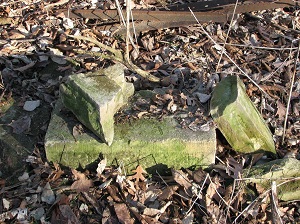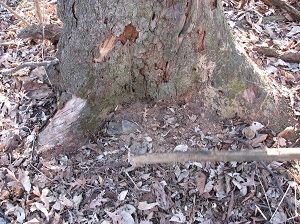Pioneer Cemetery
"Ely Woods Burials"
Compiled by Edwin J. Vavra of Ely, Iowa in 2019
A lifelong resident of the area and local historian
ed.vavra@gmail.comNestled
in the woods of College Township, Linn County sits a forgotten pioneer
cemetery. Little is known about this cemetery or those souls who
inhabit it. Maps have dubbed it the “Ely Woods Burials”. This report
will detail what is known about the cemetery and some conclusions that
could be drawn but will not give the location of the cemetery as it
sits on private property and is not accessible by any public means.
Personal association with the cemetery:
When I was a small boy in the 1980’s my father and I would walk the
timberlands that were adjacent to the 40 acres that we owned in land
once known as Hoosier Grove. I remember us stopping at a spot and my
father told me that we were standing in a cemetery. As a child who grew
up going to the First Presbyterian Church, I heard rumors of a cemetery
and gravestones in the woods near the church and I assumed this must be
it.
There were very little if any clues that were immediately
obvious to me to indicate a cemetery was here. There was a base stone
of a marker. Underneath the foliage there were more signs of smaller
markers. All the stones appeared situated around a large evergreen
tree, which in contrast to the surroundings, was all by itself and upon
further reflection, quite out of place.
I was immediately
curious about this cemetery and how my father knew of it. As I pressed
him for information, I learned that he and his parents came across it
while mushroom hunting. He recalled there was a stone marker still
standing that bore the name ‘Priscilla Scott’; a name he never forgot.
His father had known about this place but only said that people were
buried there. Since that day we have always referred to this place as
the “Scott Cemetery” as do the few locals who know of its existence.
I
last visited this cemetery in 2009 with my father and son. I took
photos and marked the coordinates with a handheld GPS. Despite the base
of a stone (which my father said was where the Priscilla Scott stone
sat) and some metal fence posts (put there by Robert Fajmon, who
intended to fence it) there is no evidence of a cemetery. The tree that
the stones seems to surround had been struck by lightning, was dead and
slightly leaning. All signs it was ever an evergreen had gone.
About Priscilla Scott:
Genealogical research for Priscilla reveals that she was born in
Illinois about 1837 to Abner and Susannah (Johnston) Cox. A history of
Linn County published in 1878 credits the Cox family as one of the
earliest settlers in the area:
HOOSIER GROVE SETTLEMENT Pioneers crossed the Cedar in 1838 and located in the second township
west of the line in the southern range being Town 82 north Range 6 west The fertile region of what is
now known as Putnam Township and the grove of timber then deemed indispensable to settlers caused
the first party to locate near the present town of Ely. This company consisted of Elisha Cox and Isham Holler
who claimed land on the creek which ran through the grove. The timber was called Hoosier Grove.
John Holler settled on the present town site of Ely and lived where Andrew Fahrmeister [Fuhrmeister]
now does. Isaac Cox located one mile west and Joseph Cox pushed on for half a mile beyond that claim
Abner Cox settled on the present Frank Lawrence [Lorenc] farm
Johnson
County marriage records show Priscilla, age 17, married to a
20-year-old Irishman by the name of Richard Scott on Oct 2, 1854. The
newlyweds farmed land on the north central border of Section 25 in
College Township, Linn County.
Age of the cemetery:
The first clue to the age of this cemetery comes from the March 15,
1877 Cedar Rapids Weekly Times. The article titled “A Disastrous Fire”
notes the following: Wednesday morning of last week about 4 o’clock,
during that fearful cold snow and wind storm, the residence of Richard
Scott, near Ely, was burned… Mr. Scott was awakened by the roaring of
the flames and had but barely time to seize the little ones of his
household…
The
article continues and includes details of the fire and the family and
states “The family consists of eight children, ranging in age from 15
to 2 years old” with no mention of his wife until later in the article
where it notes “Mr. Scott lost his wife about a year ago, and he was
struggling along as best he could to keep his family together”. Since
Iowa did not require death records until 1880 there is likely no exact
date of Priscilla’s death and we can only guess she died in early 1876
based on this article.
Another reference, not verified, but
likely the same cemetery, was made by Mr. John Pratska who wrote
memories of his childhood for the Ely Centennial in 1972. Pratska was
born in 1885 around Oxford Junction but grew up in Ely. He writes: It
was here at Hoosier Grove that I found a cemetery quite by accident. It
was when I roamed near the John Janko timber, looking for wild black
raspberries. A sunken grave was concealed by the berry bushes and I
fell into this pit, and found in it a broken sandstone marker with
inscribed lettering, giving the name of the deceased, person, also when
he was born and when he died. I looked around and saw more stones, but
not many, and the dates showed that some were buried in the 1860’s, the
Civil War days. I had not paid this place a visit since, though it is
my wish to go back to read some names of those buried there.
Other References:
My
father said George Motycha (1895-1991, mother = Agnes Buresh) who owned
nearby land and Joe Skripsky (1909-1987), brother of a longtime
landowner where the cemetery was located, both estimated 6-12 graves
there based on their recollections from their visits in earlier days.
Personal Conclusions:
I
believe this cemetery to be a true “Pioneer” cemetery in the sense that
the first settlers of the area may be buried here; specifically,
members of the Cox family mentioned earlier. Prior to about 1862 there
were no formal cemeteries in the immediate area. Did the Cox family
bury their family members in the timber on their property? This would
explain Priscilla (Cox) Scott being buried on land that was owned by
her uncle, Isaac. The first formal cemetery in this area was
established in 1863 by the Buresh family and 4 years later the
Bohemian church founded their cemetery just over one mile directly
south of the Buresh one, both cemeteries were used by the Czech
immigrants.
The Future:
While
there is little left of this cemetery there is still much more we can
learn about it. The names of the souls who rest there would be valuable
to understanding its origins.
I learned at some point and due
to suspicious trespassing, Joe Skripsky had removed all the fallen
stones from the cemetery fearing they might be taken. He moved them
into a fence for later retrieval.
In the early 1990’s the First
Presbyterian Church near Ely was given land by the George Motycha
estate. One church elder told me that he and another member walked the
Motycha timber and remember finding old gravestones in the fence line,
however, this was some fifteen plus years later and he did not remember
where they were but confirmed to me on a map the general area where
they were found. I plan to obtain permission and walk this land in
hopes the stones might be found and the names of those in the cemetery
identified.
1895 Landowner map of College Township,
Linn County Iowa, Sections 25 and 36.
1. Joseph Buresh farm where George Motycha was born and lived his whole life
2. Richard Scott (husband of Priscilla Cox) land
3.
Land where Isaac Cox settled, later became the John Janko farm
(referenced by Pratska). Cox owned more adjacent property prior to this
farm in the 1860’s. This property is where the cemetery is located but
is not shown on this map. |
 |  |  |
| Figure 1. Base of tree and Priscilla Scott base stone | Figure 2. Close up of Priscilla Scott base | Figure 3. Stone seen embedded in base of tree |

